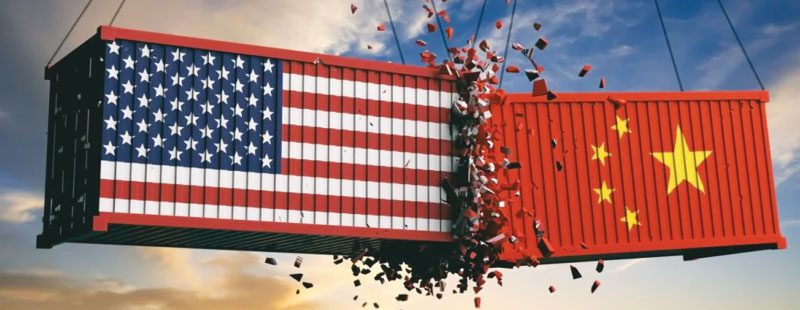
JOHN DOE SEPT 15, 2017
US-China Trade War
Economic Impacts and Developments (2018–2025)
Key Events
- Initiation (2018): The trade war began when former US President Donald Trump imposed tariffs on Chinese goods, citing unfair trade practices like intellectual property theft and forced technology transfers [1, 9].
- Tariffs and Retaliation: The US imposed a 34% "reciprocal tariff" on most Chinese imports, with China retaliating with matching tariffs on US goods, targeting sectors like agriculture [1, 4, 9].
- Escalation (2025): Tariffs escalated significantly, with the US imposing a 145% tariff on Chinese goods and China responding with a 125% tariff on American goods [1, 9].
- Trade Deficit: The US trade deficit with China, reaching $295 billion in 2024, remains a central issue, with tariffs failing to reduce it as intended [1, 5, 9].
Economic Impact
- Higher Prices: Tariffs have increased consumer and business costs, with US consumer prices rising by approximately 0.5% annually and specific goods like washing machines surging by 12% [1, 4].
- Job Losses: The trade war has led to significant job losses in the US, particularly in manufacturing and agriculture, with estimates of 801,000 net job losses by 2025 [6, 18].
- Supply Chain Disruptions: Global supply chains have been disrupted, with companies relocating production to countries like Vietnam and Mexico to avoid tariffs, increasing manufacturing costs by 10-30% [1, 2, 19].
- Global Economic Impact: The trade war has slowed global GDP growth by an estimated 0.8 percentage points, with projections of up to a 7% reduction if tensions escalate further [1, 5, 7].
Current Status (2025)
- Ongoing Tensions: The trade war continues with high tariffs, though a temporary de-escalation in May 2025 reduced US tariffs to 30% and Chinese tariffs to 10% for a 90-day period [3, post:6].
- New Developments: In 2025, the US imposed additional levies on Chinese electric vehicles, solar panels, and semiconductors, targeting strategic industries [1, 2, 9].
- Diplomatic Efforts: Both nations are engaging in talks, with posts on X indicating potential extensions of tariff pauses and negotiations over chip exports [post:5, post:7].
Potential Outcomes
- Resolution: A resolution could involve tariff reductions and agreements addressing intellectual property theft and technology transfers, potentially stabilizing trade relations [1, 9].
- Escalation: Further escalation could lead to severe economic consequences, including deeper GDP contractions (1.3% for both US and China by 2030) and increased global trade disruptions [7, 9].
Conclusion
The US-China trade war, initiated in 2018, has profoundly impacted both nations and the global economy through higher prices, job losses, and supply chain disruptions. Recent escalations in 2025, including tariffs on electric vehicles and solar panels, underscore ongoing tensions, despite temporary de-escalations. A resolution hinges on diplomatic efforts to address trade imbalances and intellectual property concerns, but further escalation risks significant economic fallout. Continued negotiations and strategic adjustments are critical to mitigating these challenges.